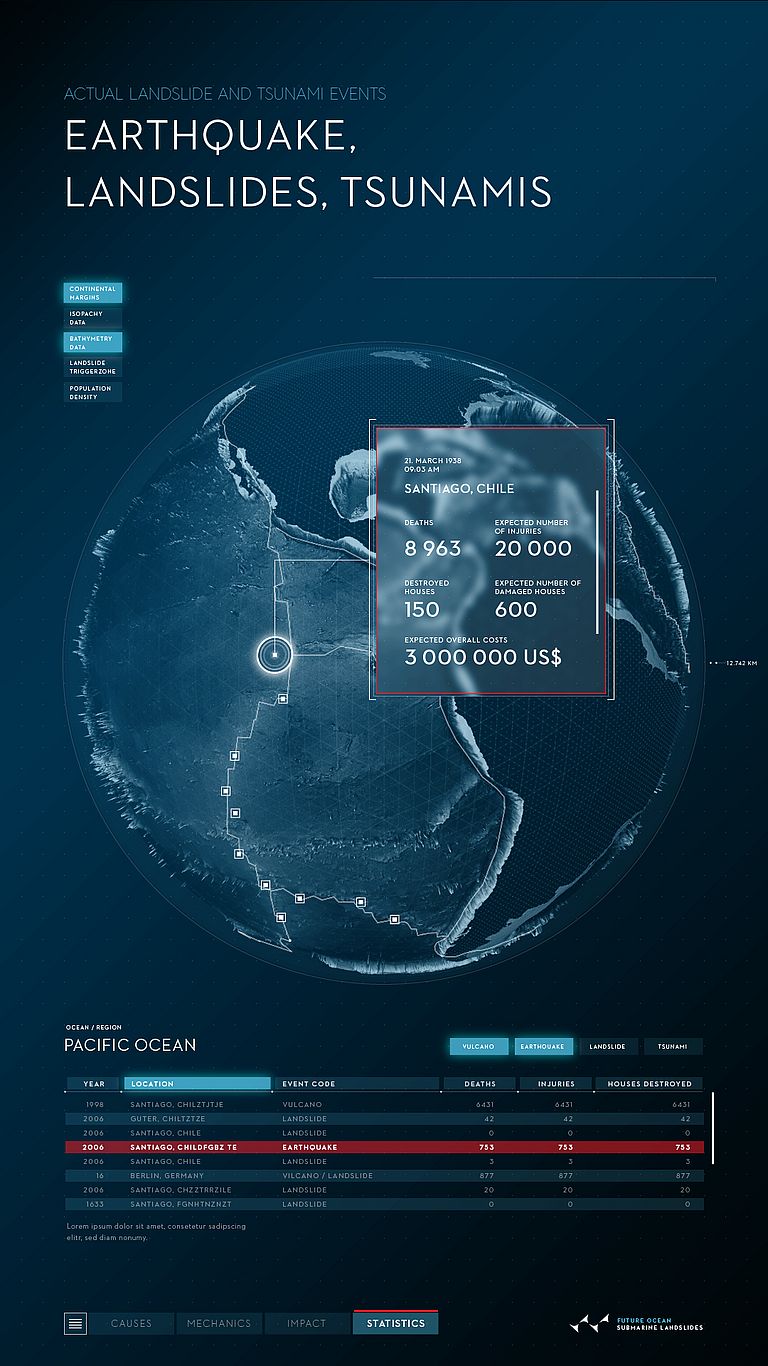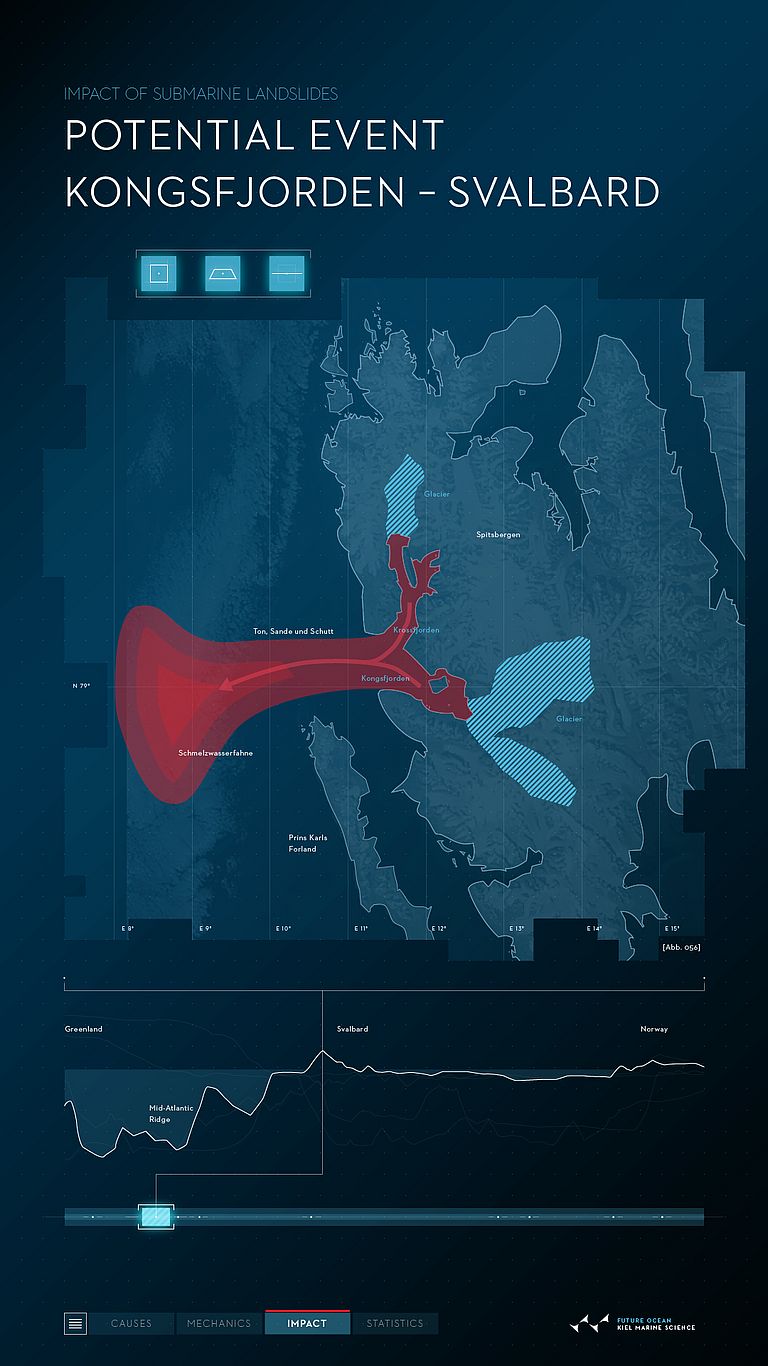Interactive: The Future of Scientific Knowledge Transfer
Information designers of the Muthesius Academy of Fine Arts and marine scientists from the Cluster of Excellence "The Future Ocean" develop interactive science posters
The interactive poster consists of a 55-inch monitor with a touch screen that displays the scientific content of complex graphics, animations and video sequences. During the world's largest conference on so-called submarine landslides, taking place in Kiel September 23-25, this technology celebrated its premiere. The event is organized by the Cluster of Excellence "The Future Ocean" and GEOMAR Helmholtz Centre for Ocean Research Kiel.
The reason for the extensive development of Tom Duscher, Professor of Interactive Information Design and Digital Media at the Muthesius Academy, and information designer Konrad Polzer was the perception that conventional scientific posters are typically just as complex as the topics they represent. Often the described processes and their graphical representations are barely comprehensible to outsiders. "The objective of the digital poster is to provide an understandable way of presenting complex scientific content," said Tom Duscher, expert for scientific visualization at the Muthesius Academy. "This is facilitated by a clear operating concept and content structuring. In that way, the user determines the desired depth of information - according to scientific education."
The science poster also offers a futuristic look, interactive elements and animated infographics. "Research topics can be presented in an easily understandable format by this display," says Information designer Konrad Polzer. "In addition, the digital poster can also be used outside of science, such as at exhibitions and in education. And it's also a lot of fun".
The theme of the first poster is the Storegga landslide that gained notoriety outside of science by the novel "The Swarm” of Frank Schätzing: Approximately 8,000 years ago, off the coast of Norway, a landslide of the size of Iceland had triggered a tsunami and destroyed large parts of coastal northern Europe. The digital poster provides the causes, mechanisms and consequences of such landslides and explains typical situations that can trigger underwater landslides in an easily understandable way.
Such landslides are among the most underrated natural hazards and they are poorly understood. "With this interactive poster we want to explain the processes behind major landslides and the main factors that lead to unstable slopes and thus to landslides," says Dr. David Völker, a geologist at GEOMAR Helmholtz Centre for Ocean Research Kiel.
For the poster, the scientists and designers have used the not hypothetical but not unlikely case scenario of a future event similar to the Storegga landslide: a slope on the continental shelf off Spitsbergen (Svalbard) could plunge into the abyss and cause tsunami that is comparable to the one 8,000 years ago. "The digital poster helps us to understand past events in order to get an idea about the likelihood of events that are yet to come. The interesting thing about Svalbard is that todays conditions are somewhat similar to those off central Norway 8000 years ago, and also that this is one of the few stretches of the slope that have not yet come loose to date," says Völker.
High resolution images:
Premiere of the interactive poster during the Symposium on Submarine Landslides. Information designer Konrad Polzer (left) and Dr. David Völker (right) introduce the format to the science community.
New formats in science knowledge transfer. Screenshot of interactive poster. Photo: Konrad Polzer
Contact
Tom Duscher, Muthesius Academy of Fine Arts and Design, td(at)muthesius.de, Phone: +49-431-5198478
Konrad Polzer, Information design, info(at)konradpolzer.de, Phone: +49-431-53011140
Jan Steffen (Communication & Media), Phone: +49-431 600 2811, presse(at)geomar.de
Friederike Balzereit, Cluster of Excellence "The Future Ocean (Public relations), fbalzereit(at)uv.uni-kiel.de, Phone: +49-431-880-3032




